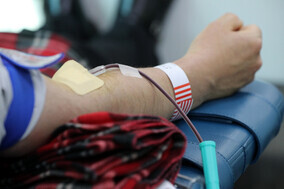hankyoreh
Links to other country sites 다른 나라 사이트 링크
Only around 100 out of some 12,000 recovered COVID-19 patients have donated their blood

Time is running out for making optimal use of the blood of those who have recovered from the novel coronavirus in the development of convalescent plasma therapy, but barely more than a hundred of the 12,000 or so recovered patients in the country have donated their blood. That has led to calls for the Korean Red Cross to take more action to arrange a steady supply of blood.
According to Korea’s Centers for Disease Control and Prevention (KCDC), 309 recovered COVID-19 patients had agreed to provide blood as of July 6, and only 132 of them had completed the plasma donation process. The Daegu branch of the Shincheonji religious group recently announced that it plans to have 4,000 recovered members donate their plasma, but official deliberations between the branch and the KCDC are reportedly still ongoing.
There are high hopes about using convalescent plasma to treat COVID-19, since the therapy is fairly stable and development could be completed as early as this year. The Korea National Institute of Health, under the KCDC, and a private company called GC Pharma are working jointly on developing this therapeutic approach.
But the number of blood donors — which are absolutely required for developing the treatment — has increased at a snail’s pace. Industry sources say that the development phase alone requires blood from about 150 people (500ml per donation). Once the therapy moves into production, even more will be needed.
More importantly, some research indicates that the neutralizing antibodies that make convalescent plasma effective quickly disappear about three months after recovery. That has prompted serious concerns that a chance to develop the best medication is being wasted.
Major reason for shortage is there are only 4 hospitals collect plasmaOne major reason for the shortage of plasma donors is the issue of access for those who want to give. There are currently only four sites in the country that accept blood donations for plasma therapy: Korea University Ansan Hospital, in the capital area, and Keimyung University Dongsan Medical Center, Kyungpook National University Hospital, and Daegu Fatima Hospital, in Daegu. Plasma donors have to take an initial test and then return to the same hospital a week later to make the actual donation, while only being paid enough to cover their transportation.
Given the relevant capacity of the Korean Red Cross’s blood management office, South Korea’s pharmaceutical industry is calling for the office to mobilize its blood donation buses, which are equipped with blood collecting equipment. The office’s blood plasma donation buses can process 30 people a day and could also reduce the emotional stigma of recovered patients mixing with those who haven’t been infected. Legally speaking, only hospitals are allowed to collect plasma (Article 33 of the Medical Service Act), but the government made an exception for the blood management office this past May.
“We already used our blood plasma donation buses at Kyungpook National University Hospital last month at the request of the Ministry of Health and Welfare. While we don’t have any information about who was infected, we will look into playing an active role if we’re asked to do so by the government,” said a member of the external cooperation team at the blood management office.
By Hong Seock-jae, staff reporter
Please direct comments or questions to [english@hani.co.kr]

Editorial・opinion
![[Column] Is Korean democracy really regressing? [Column] Is Korean democracy really regressing?](https://flexible.img.hani.co.kr/flexible/normal/500/300/imgdb/original/2024/0705/2917201664129137.jpg) [Column] Is Korean democracy really regressing?
[Column] Is Korean democracy really regressing?![[Column] How tragedy pervades weak links in Korean labor [Column] How tragedy pervades weak links in Korean labor](https://flexible.img.hani.co.kr/flexible/normal/500/300/imgdb/original/2024/0703/8717199957128458.jpg) [Column] How tragedy pervades weak links in Korean labor
[Column] How tragedy pervades weak links in Korean labor- [Column] How opposing war became a far-right policy
- [Editorial] Korea needs to adjust diplomatic course in preparation for a Trump comeback
- [Editorial] Silence won’t save Yoon
- [Column] The miscalculations that started the Korean War mustn’t be repeated
- [Correspondent’s column] China-Europe relations tested once more by EV war
- [Correspondent’s column] Who really created the new ‘axis of evil’?
- [Editorial] Exploiting foreign domestic workers won’t solve Korea’s birth rate problem
- [Column] Kim and Putin’s new world order
Most viewed articles
- 110 days of torture: Korean mental patient’s restraints only removed after death
- 2What will a super-weak yen mean for the Korean economy?
- 3Real-life heroes of “A Taxi Driver” pass away without having reunited
- 4Koreans are getting taller, but half of Korean men are now considered obese
- 5[Column] Is Korean democracy really regressing?
- 6Ahead of 2018 Olympics, hanok village opens in Gangneung
- 7Members of North Korea’s cheerleading squad reflect on their Olympic experience
- 8Democrats ride wave of 1M signature petition for Yoon to be impeached
- 9Former bodyguard’s dark tale of marriage to Samsung royalty
- 10In the blink of an eye, an unthinkable crash turned a night out into a nightmare